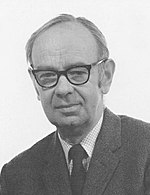Alan Robertson (geneticist)
Alan Robertson FRSE | |
|---|---|
 Alan Robertson | |
| Born | 21 February 1920 |
| Died | 25 April 1989 (aged 69) |
| Citizenship | British |
| Education | Liverpool Institute High School for Boys |
| Alma mater | University of Cambridge (BA) |
| Awards |
|
| Scientific career | |
| Fields | Population genetics |
| Institutions | University of Edinburgh |
| Doctoral students |
|
Alan Robertson
In addition to his work on agricultural genetics, Robertson undertook extensive studies of other branches of genetics, developing an influential secondary theorem of natural selection. He acquired an international reputation, receiving state and academic honours from Europe, America and Asia.[6]
Education and early life
Robertson was born in Preston, Lancashire, the second and only surviving child of John Mouat Robertson, an employee of the Post Office, and his wife Annie, née Grace, who was the younger sister of the University of Cambridge mathematician John Hilton Grace. Annie Robertson died within days of his birth, and Alan was brought up by his aunt Bessie Grace on the family farm at Halewood, near Liverpool.[4] He was educated at Halewood village school from where he won a scholarship to the Liverpool Institute High School[7] in 1930. He distinguished himself there in languages and in science under the tutelage of the chemistry master L. A. Naylor.[4] In 1938 he won a scholarship to Gonville and Caius College, Cambridge, to read chemistry. He graduated in 1941 with an upper second class degree, and became a research student in the Department of Colloidal Science at Cambridge.[4]
During the Second World War Robertson served in the Operational Research Section of Coastal Command. The head of the unit was
Research and career
After spending nine months in the US receiving training in genetics and animal breeding with Sewall Wright and Jay Laurence Lush, Robertson took up his work at NABGRO, based in Edinburgh. The organisation was split into two parts, and Robertson became a member of the Unit of Animal Genetics, where he spent the rest of his career.[8] At first he worked on improving dairy cattle using mathematical and statistical methods to devise the most effective breeding programmes. Away from the everyday work of the Unit, Robertson also worked on evolutionary biology, studying how variation is maintained in populations, and particularly the roles of mutation and of stabilising selection. Hill writes that Robertson made "original contributions to the theory of genetic change in small populations and introduced a theory of limits to artificial selection … a combination of mathematical insight, quantitative genetic principles, and practical context, of which only he was capable."[8]
Robertson continued to work on dairy-related research and wider theoretical studies. He did much to introduce widespread use of artificial insemination in dairy cattle,
Awards and honours
Robertson was elected a
The Alan Robertson chair of Genetics at the University of Edinburgh is named in his honour. As of 2016[update] the post is held by Paul M. Sharp.[9]
Personal life
In January 1947, Robertson married Margaret Bernheim, a NABGRO colleague, with whom he had two sons and a daughter.[8] He was a member of the Farmers Club.[7] Robertson retired in 1985, and died in Edinburgh in 1989, aged 69.[8]
References
- ^ EThOS uk.bl.ethos.652442.

- ^ EThOS uk.bl.ethos.502971.
- ^ EThOS uk.bl.ethos.330579.

- ^ PMID 11616177.
- PMID 2187742.
- ^ "Alan Robertson (1920–1989)". Guelph: University of Guelph. Archived from the original on 7 February 2012.
- ^ doi:10.1093/ww/9780199540884.013.U168592. (Subscription or UK public library membershiprequired.)
- ^ doi:10.1093/ref:odnb/40019. (Subscription or UK public library membershiprequired.)
- ^ "Professor Paul M. Sharp, FRS, FRSE, MRIA: Alan Robertson Chair of Genetics". Edinburgh: University of Edinburgh. Archived from the original on 12 April 2016.
